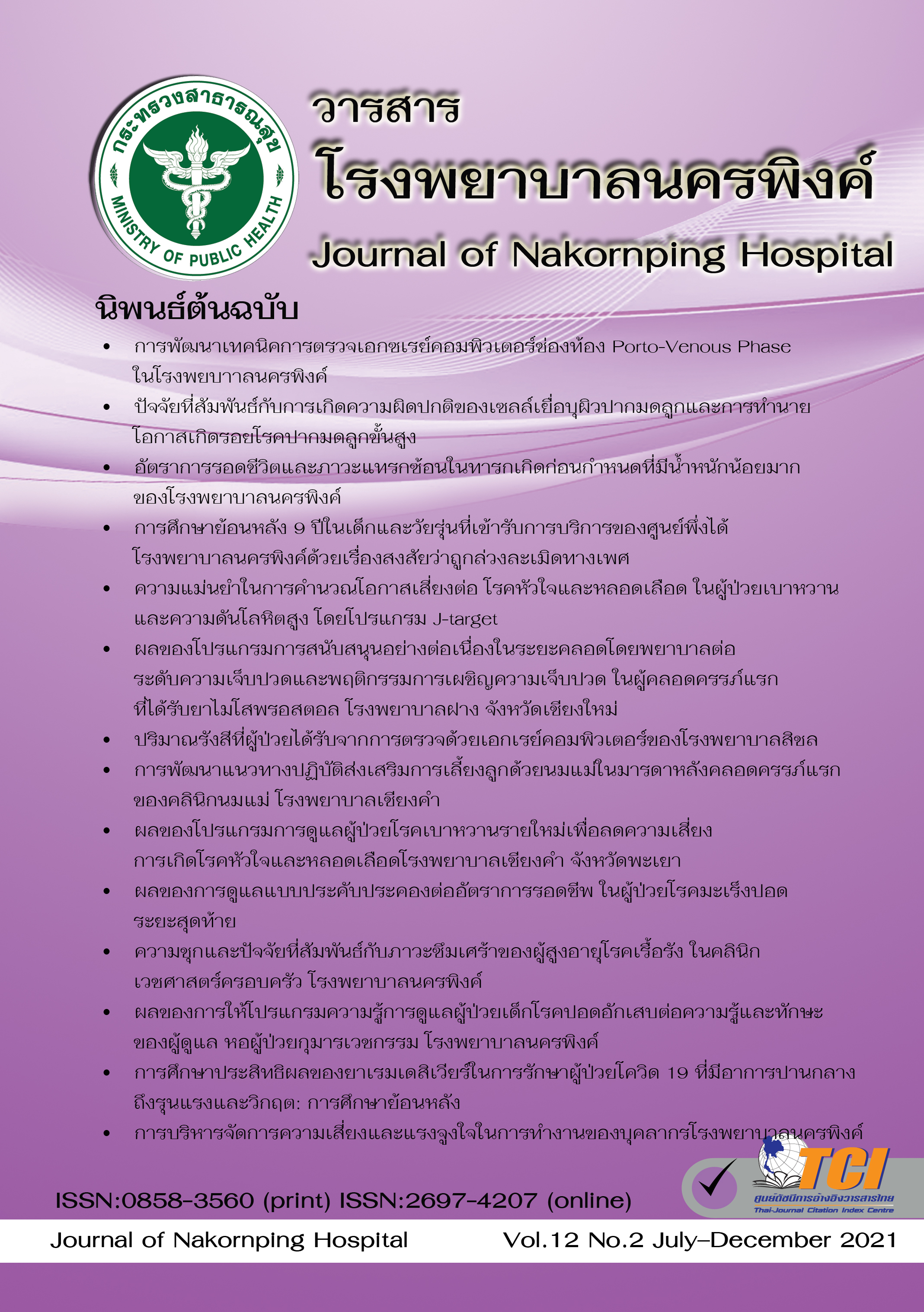A nine-year retrospective study of children and adolescents reported at the One Stop Crisis Center of Nakornping hospital for possible sexual abuse
Keywords:
children, adolescent, sexual abuse, One Stop Crisis Center, OSCC, retrospective studyAbstract
Objective: To study and compare the characteristics of children and adolescents reported at the One Stop Crisis Center of Nakornping hospital suspected of child sexual abuse cases.
Method: Retrospective study was conducted by reviewing of medical records, forensic medical record form and One Stop Crisis Center record form of 303 children and adolescents suspected of being sexually abused who were treated at Nakornping hospital between January 1, 2012 and December 31, 2020. Data were analyzed by using descriptive statistics and the Fisher’s exact test.
Results: Total -303 children and adolescents were reported at the One Stop Crisis Center of Nakornping hospital for possible sexual abuse. Most of the cases were females (88.8%) and adolescents (67.7%). The study had found statistically significant difference between children and adolescents (p-value<0.05) in reason for OSCC visit that children came with physical or mental disorders (54.1%) while adolescents came with being in a dangerous situation (41.5%). Adolescent had more concern in the issue of duration since the incident to OSCC visit which was later than 72 hours, perpetrators were known one, most identify number of offeners was one, repeated incidents, abuse incident which had occurred outside home, abuse which was rape with threats or body harm and had reported to prosecutions than in children. On physical examination, 79.6% of children had no genital and anal lesions, while 55.1% of adolescents had old wounds. Adolescent had more proportion to positive test to detect sperm and acid phosphatase than children (13.7% vs. 2.0%) and (23.4% vs. 1.0%) while sexually transmitted diseases were vice versa (3.4% vs. 8.1%), which can be concluded that the victims were sexually abused (36.1% vs. 7.1%), and may be separated from their families to emergency home (37.6% vs. 22.5%).
Conclusion: Demographic characteristics between children and adolescents suspected of child sexual abuse who attended the One Stop Crisis Center of Nakornping hospital had a significant difference in many aspects to concern. Competent OSCC could help these powerless victims to define their threats and harm.
References
Bechtel K, Bennett BL. Evaluation of sexual abuse in children and adolescents. In: UpToDate, Wiley JF(Ed), UpToDate, Waltham, MA. (Accessed on February 19, 2021.)
Unicef [Internet]. New York. CSC Corporate Domains; c1993-2021 [updated 2021 Feb 21; cited 2021 Apr 18]. Available from: https://www.unicef.org/thailand/what-we-do/child-protection
สำนักงานคณะกรรมการข้อมูลข่าวสารของราชการ, ศูนย์ช่วยเหลือสังคม (OSCC). OSCC ศูนย์ช่วยเหลือสังคม [อินเทอร์เน็ต]. กรุงเทพฯ: ศูนย์ช่วยเหลือสังคม(OSCC); 2556 [เข้าถึงเมื่อ 14 ส.ค. 2564]. เข้าถึงได้จาก:
http://www.oic.go.th/FILEWEB/CABINFOCENTER18/DRAWER003/GENERAL/DATA0000/00000056.PDF
Adams JA, Farst KJ, Kellogg ND. Interpretation of medical findings in suspected child sexual abuse: an update for 2018. J Pediatr Adolesc Gynecol. 2018;31(3):225-31.
พระราชบัญญัติแก้ไขเพิ่มเติมประมวลกฎหมายอาญา (ฉบับที่ 27) พ.ศ.2562. (2562,27 พฤษภาคม) ราชกิจจานุเบกษา. เล่ม 136 ตอนที่ 69. หน้า 127-34.
อริยพร โพธิใส. ความผิดเกี่ยวกับการอนาจารเด็กตามประมวลกฎหมายอาญา. จุลนิติ 2561;15(2) :155-63.
Jenny C, Crawford-Jakubiak JE; Committee on Child Abuse and Neglect; American Academy of Pediatrics. The evaluation of children in the primary care setting when sexual abuse is suspected. Pediatrics. 2013;132(2):e558-67.
Silva WDS, Ribeiro FM, Guimarães GK, Santos MSD, Almeida VPDS, Barroso-Junior UO. Factors associated with child sexual abuse confirmation at forensic examinations. Cien Saude Colet. 2018;23(2):599-606.
Trangkasombat U. Sexual abuse in Thai children: a qualitative study. J Med Assoc Thai. 2008;91(9):1461-7.
Kellogg ND, Koek W, Nienow SM. Factors that prevent, prompt, and delay disclosures in female victims of child sexual abuse. Child Abuse Negl. 2020;101:104360.
Vrolijk-Bosschaart TF, Brilleslijper-Kater SN, Benninga MA, Linndauer RJL, Teeuw AH. Clinical practice: recognizing child sexual abuse-what makes it so difficult?. Eur J Pediatr. 2018;177(9):1343-50.
Trindade LC, Linhares SMGM, Vanrell JP, Godoy D, Martins JCA, Barbas SMAN. Sexual violence against children and vulnerability. AMB Rev Assoc Med Bras. 2014;60(1):70-4.
David N, Ezechi O, Wapmuk A, Gbajabiamila T, Ohihoin A, Herbertson E, et al. Child sexual abuse and disclosure in South Western Nigeria: a community based study. Afr Health Sci. 2018;18(2):199-208.
Bowen K, Aldous MB. Medical evaluation of sexual abuse in children without disclosed or witnessed abuse. Arch Pediatr Adolesc Med. 1999;153(11):1160-4.
Rizzo A, Ricard D, La Harpe R, Fracasso T, Yaron M. Female Child and Adolescent Sexual Abuse Cases Reported at the Geneva University Hospitals Between 2006 and 2014: A Retrospective Study. J Pediatr Adolesc Gynecol. 2020;33(3):260-3.
Sena CA, Silva MAD, Falbo Neto GH. The incidence of sexual violence among children and adolescents in Recife, State of Pernambuco, Brazil, in 2012 and 2013. Cien Saude Colet. 2018;23(5):1591-9.
Fanslow JL, Robinson EM, Crengle S, Perese L. Prevalence of child sexual abuse reported by a cross-sectional sample of New Zealand women. Child Abuse Negl. 2007;31:935-45.
Enyedy A, Tsikouras P, Csorba R. Medical and legal aspects of child sexual abuse: a population-based study in Hungarain County. Int J Environ Res Public Health. 2018;15(4):701-9.
Boonma M, Bhoopat T, Treratwerapong T, Jintanadilog A. Physical effects of sexually abused children and adolescents at Taksin hospital. J Med Assoc Thai. 2007;90(12):2608-15.
Kotzé JM, Brits H. Child sexual abuse: The significance of the history and testifying on non-confirmatory findings. Afr J Prm Health Care Fam Med. 2019;11(1):e1-e7.
Kellogg N; American Academy of Pediatrics Committee on Child Abuse and Neglect. The evaluation of sexual abuse in children. Pediatrics. 2005;116(2):506-12.
Lahoti SL, McClain N, Girardet R, McNeese M, Cheung K. Evaluating the child for sexual abuse. Am Fam Physician. 2001;63(5):883-92.
Downloads
Published
How to Cite
Issue
Section
License
The articles that had been published in the journal is copyright of Journal of Nakornping hospital, Chiang Mai.
Contents and comments in the articles in Journal of Nakornping hospital are at owner’s responsibilities that editor team may not totally agree with.



